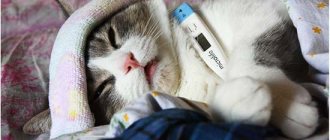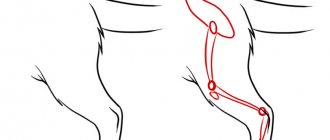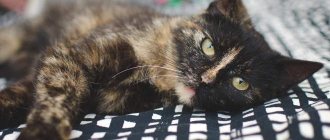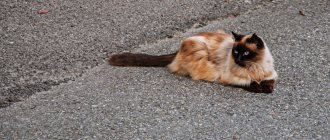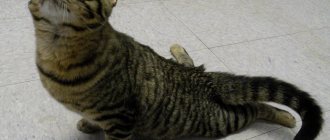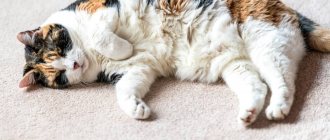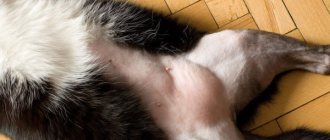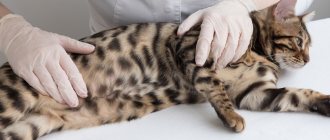If a cat has a bald belly, paws or withers, this may indicate a pathology. Only a veterinarian can find out the true cause; more details in the article.
The process of hair loss in both humans and animals is called alopecia . Hair loss in a cat can be accompanied by dermatitis and wounds, but it can also be asymptomatic. First you need to determine the cause of alopecia.
Read another interesting article on our website on the topic: “Behavior of Domestic Cats” . You will learn how to understand what your cat is trying to tell you.
From this article you will learn why it happens that cats go bald. You will also know how to diagnose and how to treat an animal with similar problems. Read on.
Why the cat’s stomach and hind legs are bald: reasons
The cat's belly and hind legs are bald.
Any process of changing a cat's fur is called molting. It can be physiological or pathological. The fur on a cat's back is always thicker than on its belly. Therefore, when you lose hair, your belly will be exposed first. The cat adapts to life in a house or apartment. Typically, seasonal shedding does not occur, as in wild cats; the coat changes gradually.
So, why does the cat's stomach and hind legs become bald? The intensity of hair loss may increase for the following reasons:
- Juvenile molt . Can be observed in kittens older than 5 months . Lasts 3 months . Children's wool is replaced with new ones.
- Pregnancy and lactation . During the production of hormones, the hair on the belly falls out. Since newborn kittens suffer from a lack of warmth, it is necessary for the mother to warm them with her bare belly. And for feeding, it is also desirable that there is no hair around.
- Old age . The state of the body of older animals changes at the hormonal level. Chronic diseases appear, which often lead to the disappearance of the coat.
Standard shedding is not a serious problem. This is normal, especially if it is seasonal (spring or autumn). The cat simply changes in appearance when the temperature changes. However, if molting is accompanied by a deterioration in the cat’s well-being, a decrease in its activity and health problems appear, you need to contact a veterinarian.
Psychogenic alopecia
Hair loss in cats can be psychogenic in nature. That is, the cause in this case is obsessive behavior. For no apparent reason, a completely healthy, well-fed and well-groomed cat goes bald in a short time. With careful observation, the owner may notice some features: the cat is overly preoccupied with grooming procedures.
When a cat constantly licks, bites and pulls out fur, it not only violates the integrity of the coat, but also injures the skin. In bald areas, areas of redness, sores and sores may form. To get rid of the pain, the animal licks the injured areas even more, which only worsens the situation.
This behavior is called biased. If a cat is in a stressful situation for a long time, for example, he cannot catch a bird outside the window, or is limited in physical activity, he shifts the action to himself, as if he is self-soothing. The most common expression of biased behavior is “self-grooming.”
The reasons that cause psychogenic baldness can be very different:
- Isolation and limitation of physical activity.
- The appearance of a new member in the family - it can be a new pet or a newborn baby. The focus of attention shifts to the “new guy,” and this fact causes negative emotions in the cat.
- Separation from owner or family members.
- Repair or relocation.
- Boredom.
These problems can be avoided if you pay enough attention to the cat: play with it often, caress it, provide conditions for normal physical activity, and take care of its psychological comfort.
Pathological causes of hair loss in cats: what's the matter?
The cat's belly and hind legs are bald.
The cause of pathological hair loss on the belly can be a number of factors. What's the matter in this case? Here are the pathological causes of hair loss in cats:
- Unbalanced diet
If you choose economy-class food or regular products, your cat may not have enough “building material” to form a coat. The reason is not only a lack of vitamins, but also their overdose.
- lice eaters
These are parasites that feed on wool.
- Helminths
Worms, worms that secrete endotoxins. The latter affect the hair follicles and also prevent vitamins in the gastrointestinal tract from being absorbed into the body. Signs of worms include diarrhea, vomiting, refusal to eat, etc.
- Stress
Moving, exhibitions, fright and the appearance of a new animal in an apartment or house, or in a cat’s body, often cause hair loss.
- Physical factors
If the house is hot and the humidity level is insufficient, failures in the animal’s thermoregulation occur. It saves itself from overheating by shedding excess “clothing”.
- Chemical factors
With frequent bathing, hair may also fall out, since detergents destroy the sutured hair membrane.
- Hormonal imbalances
Their causes are malfunctions of the thyroid gland, adrenal glands and uncontrolled use of steroid drugs.
- Chronic intoxication
Appears if your pet eats food that is infected with a fungus or contains toxic substances. The poison is removed from the body not only through diarrhea and vomiting, but also along with the hair.
- Allergy
An allergy can be to individual components in food, household chemicals, cosmetics, parasite repellents, and the hair of other animals. The cat begins to itch and licks the places where the rash and itching appear. Due to diligent licking, hairs may disappear.
- Fleas
Parasites often change the pet’s behavior - the cat begins to itch sharply. Itching can bother a cat even at night. The animal bites off whole pieces of fur, and the places it scratches become covered with crusts. Wounds are often accompanied by infections (pus is formed). With a large flea population, the cat’s general condition worsens - he loses weight, becomes restless and angry. Even people can suffer from fleas - the parasites bite their feet.
- Ticks
When a pet is infested with ticks, bald spots may appear on the face (in the ear area) and on the front legs. Baldness is located symmetrically. It is accompanied by severe itching. Wounds often fester. Skin mites in cats are microscopic and appear in those who suffer from weak immunity. Areas of bare skin turn red and become covered with dry scales.
- Lichen
This fungus is also dangerous for humans. Ringworm appears as round lesions with chopped off hair. The skin turns red and becomes covered with scales, and the cat constantly scratches the affected areas. Over time, the lesion increases in size.
- Adenitis
It is an inflammation of the sebaceous glands. Usually due to genetic predisposition. Adenitis most often affects kittens and older animals. Bald spots are round. They form in the ears, neck and head. The disease is accompanied by an unpleasant odor. The skin becomes yellow or gray and clammy. Adenitis and eczema should not be confused.
- Folliculitis
An infection that affects the hair follicles. It causes hair to become brittle. Inflamed blisters form on the face and neck. The cat is suffering from itching. The reason is allergies or weak immunity.
- Alopecia areata
There are two types:
- Autoimmune - represents the periodic appearance of bald spots. The fur is gradually recovering. The cat does not suffer from itching.
- Symmetrical – when baldness appears in the groin, stomach and thighs. It is much less common.
If such symptoms appear, you and your cat should consult a veterinarian.
- Seborrhea
It can be congenital or acquired. The affected areas are covered with small scales. Dandruff appears on your pet's fur and gives off an unpleasant odor.
- Hypothyroidism
Genetic pathology can cause complete hair loss in childhood. Newborn kittens have sparse fur. At 3-4 months, kittens become completely bald. Be careful, because without fur, a kitten can freeze in winter or overheat in summer. Pay attention to your cat's drinking regime in the summer and keep him warm in the winter.
- Hyperthyroidism
Malfunctions of the thyroid gland and an increased amount of hormones lead to seborrhea. The cat constantly licks itself, and with simple stroking, its fur will easily fall out. This reaction can be caused by any hormonal disorder:
- Adrenal diseases
- Malfunctions of the pancreas
- Problems with the ovaries or testes
Regular use of hormonal medications also often causes strong hormone production. The cat drinks a lot of water, goes to the toilet often, and its abdominal cavity increases in size.
- Oncological diseases
When a tumor forms, the hair completely falls out in the lower part of the body. Gradually, bald spots spread to the chest and paws. At the end of the disease, the cat loses most of its hair.
Treatment
As a rule, an accurate diagnosis for balding cats is made by a veterinarian. He also prescribes the necessary treatment. It is usually aimed at treating hair loss and combating the underlying disease. Therefore, there are several different ways to restore hair:
- If a cat becomes very bald on its belly due to poor nutrition, a special diet is prescribed for it.
- If alopecia is associated with allergies, then the first step is to exclude contact with the allergen, after which the animal is prescribed medications to strengthen the body’s immune system.
- Alopecia caused by skin diseases is treated with a course of antibiotics. The most common use is amoxicillin, but you should consult your doctor before using the drug.
- When abdominal hair loss is associated with stress, the animal is prescribed sedatives.
- In the case when a bald spot on the stomach is formed due to blood-sucking parasites, the cat must be treated with special substances, and immunostimulants and vitamins must be added to its diet.
- For demodicosis, it is recommended to give the animal regular baths with the addition of one percent sulfur-selenium shampoo.
The most unpleasant treatment for both the cat and the owner will be if ringworm is detected. In this case, you will have to shave your pet’s hair and give him the following medications:
- Ketoconazole;
- Itraconazole;
- Griseofulfin.
For better absorption of the latter drug, it is recommended to give it along with a small piece of butter.
Each individual case is treated individually. Before starting treatment, you must consult a specialist. And in order to prevent alopecia, you can carry out special prophylaxis for the animal.
How to diagnose at home and in a veterinary clinic if your cat has a receding hairline?
If a cat has a receding hairline, then it is better to carry out the diagnosis in a veterinary clinic.
Since there are many causes of baldness, only a specialist can determine the true cause of hair loss. How to diagnose in a veterinary clinic if a cat has a receding hairline? Typically, a number of activities are carried out to help establish the diagnosis:
- Collecting information about the cat’s way of life and its diseases.
- Examination of the pet.
- General blood analysis. If necessary, a biochemical test may be prescribed.
- Microscopic examination of hair.
- Scrapings from the affected area of skin. This will help identify diseases that are caused by the fungus.
- X-ray and ultrasound.
It is quite difficult to determine the cause of baldness at home, but you can pay attention to the cat’s behavior:
- If baldness is accompanied by vomiting and diarrhea, there is a high probability that it is caused by worms or poisoning.
- If your cat is itching in the damaged area, this may be due to parasites or an allergic reaction. When a cat has allergies, tears usually flow from their eyes.
- Perhaps the cat's behavior has changed. Now at the slightest noise he hides under the sofa. Stress may be the cause.
- Try changing food. If after this the hairline begins to recover, the reason is in the diet.
- Check the ears and the animal. Black discharge in the ears may indicate a mite.
- If your cat reaches for the fan or tries to spend more time in the bathroom, the reason may be high temperature or insufficient humidity in the room.
Important : If there are other animals in the house, isolate them from the sick cat.
Kidney structure
The kidneys are a paired oval (bean-shaped in dogs) organ, which in cats is located in the abdominal cavity, in the center of the back (at the level of 7-8 ribs), on both sides of the spine. In this case, the left half may have greater mobility.
The kidneys are made up of nephrons, each of which contains a glomerulus (a collection of capillaries) and a system of tubules. Each nephron is reliably protected from damage by a capsule.
Externally the kidneys look like this:
- The organ is protected from damage by a fibrous capsule, which in turn is located in a fatty capsule, whose thickness depends on the weight of the animal.
- The portal includes the renal artery, through which blood enters the kidneys for purification.
- The renal vein, ureter, and lymphatic vessels emerge from the organ.
- The ureter begins in the renal pelvis and discharges the resulting urine into the bladder.
The cat's stomach, hind legs, and withers are bald: what to do, how to treat it?
If a pet has health problems, it is always a worry for the owners. After all, you want to help the animal as quickly as possible. So, the cat has a bald stomach, hind legs, and withers - what to do, how to treat it? First you need to determine the cause of the disease and eliminate it:
- Check your cat's diet . Choose hypoallergenic quality food. With the right diet, you don’t even have to look for additional sources of vitamins.
- Improve the animal's living conditions . Move his bed away from the radiator and humidify the air.
- Use parasite killers . For example, Spot-on or IN-AP .
- If you are sure that the cause is an allergic reaction , tell your veterinarian.
- If the cause is stress , use sedatives, for example, Stop-Stress or Vetspokoin .
There are special vitamins for cats against hair loss. For example, brewer's yeast helps a lot. But you should not self-medicate. Be sure to visit a veterinarian. Only he will be able to establish an accurate diagnosis and choose a method of treating the animal.
Prevention to prevent your cat from going bald
A flea and tick collar is a preventive measure to prevent your cat from going bald.
Hair loss is one of the symptoms of a deviation in the health of an animal’s body. There are preventive measures that will help the animal be healthy. So, in order for the pet to be healthy, the cat does not go bald, but is always beautiful and in a good mood, follow the following rules:
- Choose quality food . When choosing, consider the age and condition of the animal. For example, there is food for pregnant cats, kittens or cats suffering from certain diseases (therapeutic).
- Take antihelminthic courses every 3 months.
- Use flea collars. Also regularly treat cats with special drops against parasites (drip on the withers).
- Eliminate anything that may cause allergies.
- Be sure to vaccinate your animal.
- Brush and wash your cat regularly.
By paying close attention to your pet, serious illnesses can be avoided. Please note that some diseases that are accompanied by hair loss in a cat can also pose a danger to humans (for example, lichen or intestinal parasites). Therefore, be attentive to the health of your pet and if any ailments appear, consult a veterinarian. Good luck!
Tags
Feed Feeding with economy-class feed prevent the use of feed additives from premium ready-made feed. Feed your pet Food reviews anti-allergenic food and food review for breeding cats with domestic cats draw cats called cats density
Preporodorodykhovitreinarinarinarinarinarinarinarino -nyaminopiliuupiliu is a call to calling a names of alarmonal -sulfate of analiznealiznealiznealiznealism -bass -bacinus -backed -backed -backed -baculicocenitaucenita -dinode -navigables of the amytatatatominaruye -dimensor of a peripheum of aimopugar -dimensor Terian -worker -earnish -earnish -in -resort -in -reservoir

